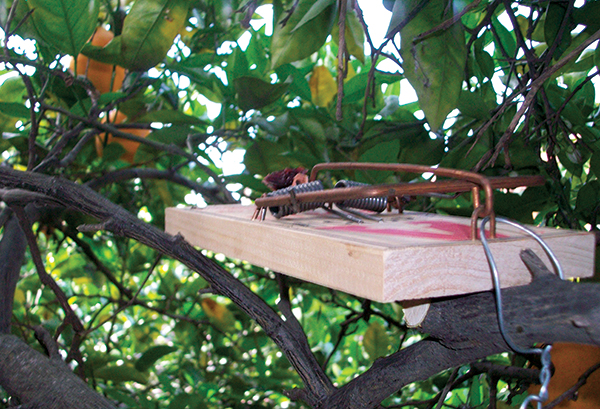Editor’s Note: This is Part II of a three-part series.

PHOTO: Dr. HANIF GULMAHAMAD
As anyone who has ever tried to secure a snap trap on an overhead pipe in a warehouse could testify, securing snap traps to tree limbs is a laborious and tedious exercise. Sloppiness and mistakes can be painful!
When roof rats travel in trees, they leave no evidence such as grease marks, runways, footprints, tail drags, urine stains or droppings to guide trap placement. I had to use my experience and better judgment in determining where to deploy snap traps in trees. To secure the traps to the limbs, I used pieces of flexible electric wires. This trap caught the big, dominant buck who ruled the mischief at this feeding site. Once he was removed, less-dominant members, including several juveniles, moved into the prime feeding location.
Using the most effective and appropriate baits on snap traps, especially outdoors, are critical. At this location, the rats were feeding on juicy orange fruits that were providing them with two of their basic needs: food and water. Baited snap traps were deployed at dusk, and checked the next morning to avoid the detrimental effects of high daytime temperatures on trap baits. Traps were rebaited with fresh bait each day at dusk.
My baits included:
- Over the years, I have used raisins on snap traps to catch roof rats in southern California with great success. But against this population, raisins were not efficacious — possibly because they were too dry.
- During periods of high temperatures, baits containing moisture, such as fresh apple slices, are preferred. However, during this trapping period, ambient daytime temperatures ranged from a high of 107° Fahrenheit to a low of 95° Fahrenheit. These elevated temperatures greatly affected the quality and palatability of fresh apples that were placed on snap traps, and they could only remain attractive and appetizing for one night.
- Using fried chicken skin as bait had both benefits and drawbacks. This strategy was employed to appeal to the keen sense of smell of rats. But it also attracted hordes of Argentine ants overnight. It also quickly dried out, and became hard under the temperature regimes reported above. Just one rat was caught using this bait.
- Even though raw walnut meats were durable and did not spoil over time, they was not efficacious under the circumstances. A good tip is to pry up the bait holder on the trigger to assist you to better attach the nutmeat. But be aware that house sparrows (Passer domesticus) will remove nutmeats from snap traps when they are set in trees.
Hanif Gulmahamad, BCE, is an urban and structural entomologist and consultant based in southern California.
Leave A Comment